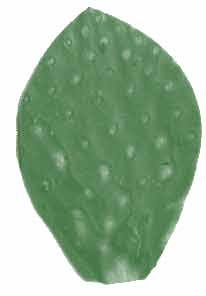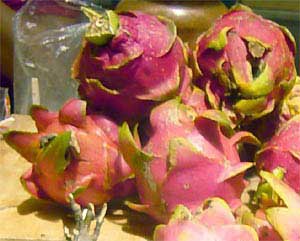

Native prickly-pear cactus, genus Opuntia of the Cactus Family, shown above, has always been eaten by Mexicans, both indigenous and mestizo. Many species and varieties of prickly-pear exist, some of them almost or entirely spineless. The ones in the picture have thorns and are grown for their fruits. If you brush shoulders with the cactus-eating culture, here are some terms you need to know
 NOPAL is the
de-thorned or never-thorned edible cactus. Above you see a green, ten-inch-long nopal pad of the type typically sold in Mexican mercados -- with its margins trimmed away and
each bump shaved or gouged out. It's important to have those whitish bumps removed because clumps of a second kind of spine -- tiny, sharp bristle called a glochid -- grow there and if eaten can cause considerable misery.
NOPAL is the
de-thorned or never-thorned edible cactus. Above you see a green, ten-inch-long nopal pad of the type typically sold in Mexican mercados -- with its margins trimmed away and
each bump shaved or gouged out. It's important to have those whitish bumps removed because clumps of a second kind of spine -- tiny, sharp bristle called a glochid -- grow there and if eaten can cause considerable misery.
NOPALITOS are sliced slivers of nopal. Nopalitos are often sold in mercados in pre-weighed plastic bags. They make a very tasty dish when fried with onions and garlic, and sprinkled with lemon juice, and constitute a favorite side dish with refried beans.

TUNAS, a yellow heap of them shown abpve (a tub of sweet potatoes, or camotes, above them) are cactus fruitx which, when ripe, contains a sweet, juicy, bright-red pulp in which many small seeds are embedded. Tunas of wild species are often so spiny that only a practiced Mexican can get at the pulp without pricking the fingers. However, the cultivated species, Opuntia ficus-indica, is practically thornless. There are three kinds of sweet tuna -- blanca, amarilla, and encarnada (white, yellow, and red, respectively) -- and a bitter one, the xoconostle verde, for seasoning stews and salsas. The Mixtecs make a drink called nochotle of the tuna by smashing it in water, straining, and adding it to the mild, poor-man's drink called pulque.

PITAYA, shown above, is another cactus fruit, this one from the genus Hylocereus, the genus of the Night-blooming Cereus. The fruit is sometimes called Dragon Fruit and Strawberry Pear. Inside they are white with little black dots for seeds. One fan refers to their taste as "refreshing and palate cleansing" and says " I have cut them in half and frozen them. Makes a nice fresh substitute for sherbet in its own shell." The cactus producing the fruit has fleshy stems reaching up to 30 feet long and may climb onto walls or over trees using aerial roots. Sometimes you see pitaya plantations where supports are provided for the clambering stems to grow over.